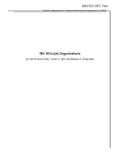Transcription of Supervision - Social Work Policy
1 Supervision :TheSafetyNetforFront-LineChi ldWelfarePracticeReport from a Think Tank SymposiumFebruary 2011 2011 National Association of Social Workers. All Rights Citation - Social Work Policy Institute (2011). , DC: National Association of Social :TheSafetyNetforFront-LineChildWelfarePr acticewas planned inconjunction with the NASW Center for Workforce Studies & Social Work Practice and theNational Child welfare Workforce Institute (NCWWI), [a service of the Children s Bureau],with Casey Family Programs (CFP) as a contributing view a video of the presentations from the symposium visit opinions expressed in this monograph are those of the more information contact:Joan Levy Zlotnik, PhD, ACSWD irectorSocial Work Policy Institute750 First Street NE, Suite 700 Washington, DC Summary ..iiiI. Goals for the Symposium ..1II. Understanding the Roles and Functions of Supervisors in Child welfare .
2 3 Identifying the Evidence Base of Child welfare Framework for Supervisory Practice ..3 Connecting Research and Practice ..5 Supervising for Racial Equity ..5 III. Preparation for Supervision ..7 Leadership Academy for Supervisors ..7IV. Professional Social Workers in Child welfare : Implications for Supervision from the 2004 National Study of Licensed Social Workers ..9V. Challenges to Quality Supervision ..13 Training and Knowledge Development ..13 Organizational Issues & Implementation of Child welfare Practices ..14VI. Recommendations for Research and Enhanced Use of Data are Necessary ..15 Professional Development and Organizational Supports forSupervisory Practice Should Be , State and Community Collaborations and PartnershipsShould Be Enhanced and and State Policy Enhancements Should Be Considered ..21 VII..23 Appendix ..25A. Symposium Agenda.
3 25B. Symposium Participants ..26C. 2010 Social Work Congress Imperatives ..29D. Symposium Speaker NCWWI Brief on Meta-Analysis ..34F. NCWWI Resource List #13: Child welfare NASW Standards, Credentials and Publications ..46H. About the Symposium Sponsors ( Social Work Policy Institute,the NASW Center for Workforce Studies, the National ChildWelfare Workforce Institute, Casey Family Programs ..49 TABLE OF CONTENTSS upervision: The Safety Net for Front-Line Child welfare Practicewas a think tank symposium thattook place on Thursday, November 18, 2010 at the NASW National Office Conference Social Work Policy Institute (SWPI) of the National Association of Social Workers (NASW)Foundation planned this event in conjunction with NASW s Center for Workforce Studies & SocialWork Practice and the National Child welfare Workforce Institute (NCWWI), with Casey FamilyPrograms (CFP) as a contributing partner.)
4 The expert presenters together with experienced childwelfare practitioners, researchers, Policy makers, trainers, technical advisors and Social workfaculty came together to examine the body of research that underscores the critical role thatsupervisors play in supporting and sustaining the workforce; underscores racial disparities thatoccur in child welfare practices, and examines initiatives that are underway to enhancesupervisory practice. The symposium participants developed an agenda for future actions thataddress research, practice improvements, professional education, knowledge dissemination andpolicy want to thank the speakers, Crystal Collins-Camargo, Assistant Professor, University of Louisville;Carol W. Spigner, Associate Professor Emerita, University of Pennsylvania; Mary McCarthy,Co-Principal Investigator, NCWWI, University at Albany; and Tracy Whitaker, Director of theNASW Center for Workforce Studies and Social Work Practice, NASW, for their detailedpresentations that framed the current environment for Supervision in child welfare .
5 The discussantsthat followed were Agnes Leshner, Child welfare Director, Montgomery County, MD; PeterVaughan, Dean, Fordham University; Marva Hammons, Director of Strategic Consulting, CaseyFamily Programs; and Roxana Torrico Meruvia, Senior Practice Associate, NASW. They broughttheir real world perspective as consultants, agency directors, front-line workers and Social workeducators to the symposium, highlighting challenges that supervisors and front-line workers face inchild welfare agencies every day and suggesting improvements that should that a larger audience of child welfare workers, students, Social work faculty and others canbenefit from the information that was presented at the symposium, the presentations by thespeakers and discussants were recorded and are available Afterviewing the two hour video, those who are interested can also receive continuing WORK Policy INSTITUTEiPREFACEIn organizing this event, many people played important roles.
6 My colleagues at the NASWC enter for Workforce Studies and Social Work Practice, Tracy Whitaker and Roxana TorricoMeruvia were my partners in planning the symposium and in identifying relevant NASW resources and publications. Mary McCarthy, Nancy Dickinson, Sara Munson, Nancy McDaniel,Charmaine Brittain, Sue Ebertsen and Freda Bernatovicz of the NCWWI team pulled togetherinvaluable background materials and helped to identify both speakers and participants. CaseyFamily Programs, served as a contributing partner, providing expert input as well as partialsupport for the symposium. Sara Munson of NCWWI and Lisa Hughes, an MSW student atVirginia Commonwealth University did an excellent job in capturing the symposium NASW and NASW Foundation staff, Robert Arnold, Danielle Spears, Bonita Davis, NouVang and Jennifer Watt all undertook important functions in making this event a success.
7 ElizabethClark, who serves both as the NASW Foundation President and NASW Executive Director,provided valuable leadership in ensuring that we focus on a critical challenge for both the socialwork profession and child welfare service report, Supervision : The Safety Net for Front-Line Child welfare Practice,and the availablevideo can serve as valuable resources for those who participated in the symposium. They will alsobe useful to administrators seeking to identify information and resources for improving supervisorypractices and staff retention; to trainers and technical advisors who are working to improve childwelfare agency performance and child and family outcomes; to Social work educators who areteaching child welfare practice, administration, Policy and research or management andsupervision; to researchers studying child welfare organizational and workforce issues orsupervisory functions; to Policy -makers who are seeking to better understand the workforce issuesthat affect service delivery and outcomes.
8 To current child welfare workers and supervisorswanting to better understand roles and functions, and to students who are planning to pursue achild welfare action agenda laid out in this report identifies steps that can be taken by many stakeholdersat the national, state and local levels to enhance child welfare service delivery and to continue tokeep the values, knowledge and skills of the Social work profession aligned with child Levy Zlotnik, PhD, ACSWD irector, Social Work Policy InstituteFebruary 2011 COMPARATIiiSOCIAL WORK Policy INSTITUTESUPERVISION:THE SAFETY NET FOR FRONT-LINE CHILD welfare PRACTICEABOUT THE SYMPOSIUMTo further our understanding of the complex and crucial role of supervisors in child welfare , theSocial Work Policy Institute (SWPI) of the National Association of Social Workers (NASW)convened an invitational symposium, Supervision : The Safety Net for Front-Line Child WelfarePractice,on November 18, 2010.
9 It was planned in conjunction with the NASW Center forWorkforce Studies & Social Work Practice and the National Child welfare Workforce Institute(NCWWI), with Casey Family Programs (CFP) as a contributing symposium highlighted the growing evidence that effective Supervision is a critical ingredientin addressing child welfare staff retention, organizational culture and climate, culturallycompetent practice, transmission of evidence-based practices, and child and family outcomes. Italso highlighted the broad array of challenges that today s child welfare supervisors face inperforming their leadership, administrative, educational and supportive functions (Kadushin &Harkness, 2002; Hess, Kanak & Atkins, 2009; NCWWI-LAS, 2010).There are expectations that supervisors be highly skilled practitioners who can implement ethicaland culturally competent practices that result in improved outcomes for children and families;who can serve as mentors to front-line workers to help guide clinical practices; who engage withthe community; who act as managers in transmitting agency policies and in evaluatingperformance; who demonstrate leadership qualities and who provide support to workers to helpthem deal with the stress and trauma of their work.
10 However, real world service delivery suggeststhat it is difficult to actualize all of these roles simultaneously, and it may not be feasible to expectto find all of these attributes in one individualCHALLENGES TO SUPERVISIONC hallenges to quality Supervision that were identified at the symposium addressed a broad arrayof issues related toKnowledge DevelopmentandTraining and Organizational Issues andImplementation of Child welfare and Knowledge Development Lack of adequate training related to the roles, tasks and competencies for being WORK Policy INSTITUTEiiiSUPERVISION: THE SAFETY NET FORFRONT-LINE CHILD welfare PRACTICEEXECUTIVE SUMMARY Inadequate knowledge of the changing populations and communities being served. Over-focus on performance of administrative functions (managing staff and workloads)of the supervisor. Insufficient research-tested models of Supervision ( , team models; identification ofnecessary education and training requirements and competencies; supervisor to superviseeratios) and how these impact outcomes for children and families.






